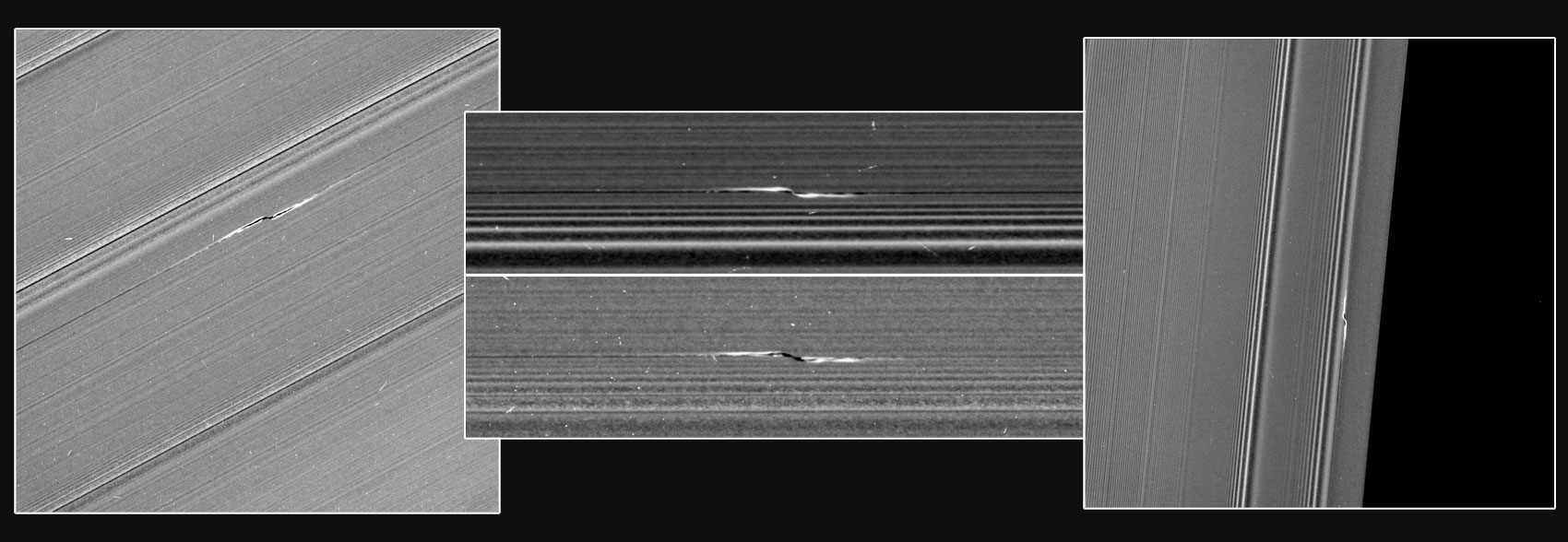Cassini and the Rings of Saturn
By Matthew S. Tiscareno
As one of its final scientific feats, the accomplished robotic spacecraft returned unprecedentedly detailed data on the material encircling the giant planet.
As one of its final scientific feats, the accomplished robotic spacecraft returned unprecedentedly detailed data on the material encircling the giant planet.

The rings of Saturn are delicate, enigmatic, beautiful, and useful. NASA’s Cassini spacecraft has been studying them (and the rest of the Saturn system) over the course of a spectacularly successful 13-year mission, but its concluding year has been the most spectacular of all—practically a whole new mission.

All images are courtesy of NASA.
In December 2016, Cassini commenced weekly plunges through the ring plane just off the outer edge of the main rings (activity termed the “Ring-Grazing Orbits”), and transitioned in April 2017 to weekly plunges between the rings and the planet’s cloud-tops (the “Grand Finale” orbits). The mission concluded in September 2017 with a final descent into the planet’s atmosphere, to preclude possible terrestrial contamination of Saturn’s moons.


The science goals of the Ring-Grazing Orbits and the Grand Finale orbits included direct sampling of particles from Saturn’s rings and atmosphere, detailed measurements of Saturn’s gravity and magnetic field to probe the planet’s interior, and unprecedentedly close-range imaging of Saturn and its rings with the spacecraft’s main camera and similar instruments. These observations followed up on discoveries made through the prime and extended Cassini missions, continued monitoring seasonal or evolving phenomena, and took advantage of Cassini’s unique proximity to Saturn in these closing stages of the mission.


Saturn’s planetary ring system is made up of countless chunks of ice, each in its own orbit around the planet Saturn. The chunks range from marble-size to house-size. The ring system is confined to the plane of Saturn’s equator and is arguably the flattest structure known to humanity, with an end-to-end dimension equivalent to circling the Earth seven times, but a vertical height about that of a house.

The moon Prometheus dips into the dusty F ring and sculpts its material. The resulting channels flatten out as they move downstream from Prometheus. Also visible in this image are several strands of dust comprising the F ring, with some bright knots that indicate embedded moons.

Saturn’s rings are useful to scientists because they provide physical and chemical clues regarding the formation and history of the entire Saturn system, they serve as detectors and amplifiers for planetary phenomena around them, and they help us understand more generally how disk systems operate, providing clues about other kinds of disks, such as baby solar systems. A few of the most compelling science questions regarding Saturn’s rings are: How do ring particles interact with one another, with moons embedded within them, and with moons farther away? Are ring particles made of ice that is fluffy or dense, pristine or sooty? What are their shapes and sizes? What structures do we see in the dusty parts of the rings, and what can we continue to learn from them?

Close-up views show giant propellers caused by ring-embedded moons. The figures in the center top portion and to the right show the lit side of the rings, where brighter tones indicate more material reflecting light. The figures in the center bottom portion and to the left show the translucent, unlit side of the rings, where most dark tones indicate more material, such that the ring becomes opaque. Cassini has tracked the orbits of these individual propellers for more than a decade and has found subtle changes in the orbits that are likely due to moon-disk interactions. These individual propellers have been nicknamed “Santos-Dumont” (middle), “Earhart” (right), and “Blériot” (left).

The structure of Saturn’s ring system is dominated by concentric bands and tightly wound spirals. Very few of these bands are empty gaps, so it is better to think of the entire system as a disk, rather than as “countless rings.” Much of the structure is not well understood by scientists, but the most common type of understood structure are waves that propagate through the rings at locations where ring particle orbits resonate (or essentially “hum in tune”) with the orbit of a moon orbiting beyond the rings. Cassini scientists discovered in recent years that a few of these waves are excited by structures within the planet Saturn.

Moons that orbit within the rings deflect nearby ring particles with their gravity and thus create a disturbance around themselves. The moons Pan and Daphnis are large enough that this disturbance becomes a sharp-edged empty gap extending around the entire circumference of the rings. Extrapolating from this archetype, scientists expected each of the dozen other sharp-edged gaps in the rings to also host a moon apiece; however, careful searches by Cassini have shown that this is not the case, so these gaps must have a more complex origin. Moons in a smaller size class than Pan and Daphnis create a propeller-shaped disturbance that is filled back in by the rings before it can extend circumferentially.

The interior and surface properties of ring particles are poorly known. Are they more like ice cubes or snowballs? Are their surfaces fluffy or slushy or frosty? The answer may be all of the above. Images from the Ring-Grazing Orbits and Grand Finale have shed new light on the collective interactions of ring particles. A speckled strawlike texture occurs within waves at locations where the particles had been recently compressed but that pressure has now been released, perhaps as a result of temporary clumps falling apart. More surprisingly, sharp-edged bands of similarly speckled texture occur at many locations within the rings, as well as streaky texture and other types of texture. Each of these textures likely indicates a different mode of mutual interaction among the ring particles, and/or different ring particle properties.

A panoramic view of Saturn shows both its main rings and its outer, dusty rings. Because the Sun was behind Saturn when this image was taken (that is, Cassini was inside Saturn’s shadow), the dusty rings appear nearly as bright as the main rings, and dusty regions that are more closely aligned with the Sun appear even brighter. The bluish E ring is composed of material ejected from the geysers on the south pole of the moon Enceladus. The Earth and its Moon are visible to the lower-right of Saturn.
The main rings are largely free of dust (that is, of icy particles that are smaller than the period at the end of this sentence), because dust tends to collect as a layer on the surfaces of larger ring particles. In the few places where dust does coexist with larger particles, it indicates the presence of vigorous ongoing activity that is keeping the dust in motion. In locations that are far from the main rings, only dust is present, and the dust then can be sculpted into shapes that reflect the forces surrounding it.

Perhaps the most fundamental mystery surrounding Saturn’s ring system is its age. Certain aspects of the dynamical interactions between the rings and moons can only be rewound for about 100 million years, indicating either that a significant reworking of the ring system’s structure occurred within that time, or that the entire ring system is only that old. An important clue in this mystery is the rate at which the rings are being polluted by “soot” falling in from the Solar System. If that infalling rate is low, or if the rings have a relatively large mass of water ice with which to mix the pollution, then it would be reasonable to conclude that the rings are as old as Saturn and still sport the relatively pure water ice we see them to have. However, if the infalling rate of pollution is high and the mass of the rings is low, then the rings are likely no older than 100 million years. Cassini’s dust detectors were working on a definitive measurement of the pollution rate, and the mass of the rings will be measured directly from the gravitational pull of the rings on Cassini during the Grand Finale orbits. After analysis of the final Cassini data has been completed, these questions should find more concrete answers.
Click "American Scientist" to access home page
American Scientist Comments and Discussion
To discuss our articles or comment on them, please share them and tag American Scientist on social media platforms. Here are links to our profiles on Twitter, Facebook, and LinkedIn.
If we re-share your post, we will moderate comments/discussion following our comments policy.